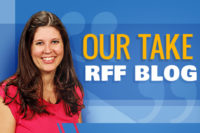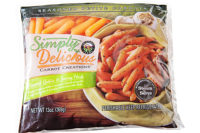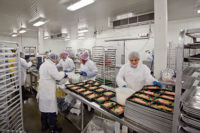Just like it takes a village to raise a child, it takes a village to master a food safety program. From the top executives down to the line operators, all parties involved
| Jump to: |
must be aware of—and able to execute—today’s ever-changing food safety regulations.
However, mastering a safe food plant is only half the battle—maintaining it is the bigger challenge. That’s why refrigerated and frozen food processors are recognizing the importance of looking both internally and externally for resources that adequately address sanitation effectiveness, says Jeff Eastman, chief executive officer for Alchemy Systems, LP.
“One challenge for a refrigerated/frozen food plant is that sanitation is often performed on a third shift. Third shifts typically have a high volume of turnover, so employee accountability can be difficult, but that’s where maintaining an effective food safety program comes into play,” he adds. “Companies who had previously tried to develop their own training materials made the switch to our SISTEM training platform to increase comprehension of important sanitation procedures.”
The Austin, Texas, manufacturer’s SISTEM (Standard Industry Skills Training and Education Media) is a training platform that enables companies to use established, industry-vetted content or develop their own training content to address critical operational needs such as the proper use of chemicals.
“By properly training the sanitation crew, sanitation standards can be consistently maintained,” Eastman says.
Sea-ing where seafood comes from
Seafood, when not handled properly, can cause a plethora of foodborne illnesses. That’s why retailers and restaurants are asking for product that is “fully
| “Within seafood cold plants, we are seeing the adoption of traceability solutions—often electronic—to ensure product can meet the requests of the retailers,” adds Boyle. “Sometimes these are solutions created by the company, and other times they are purchased software solutions and adapted for that company.” |
traceable back to its source with proof that the seafood has been harvested within management regulations (i.e. is legal), and that sustainability parameters travel with seafood through the supply chain (e.g. catch method, harvest location, etc.),” says Mariah Boyle, project director for FishWise, a Santa Cruz, Calif.-based sustainable seafood consultancy that promotes the health and recovery of ocean ecosystems through environmentally-responsible practices.
“Within seafood cold plants, we are seeing the adoption of traceability solutions—often electronic—to ensure product can meet the requests of the retailers,” adds Boyle. “Sometimes these are solutions created by the company, and other times they are purchased software solutions and adapted for that company.”
To better track and trace where seafood comes from, FishTrax developed an electronic fishery information platform that “revolutionizes the way fisheries information is collected, analyzed and shared,” according to the Newport, Ore., company. Through the use of specially designed and easy-to-use “portals,” clients can securely input and export data and information to meet the needs of a variety of audiences. The portals then help translate raw data into valuable knowledge, so users can maximize their real-time business, management, marketing and purchasing decisions.
Meanwhile, Norway-based TraceTracker offers a suite of product traceability, asset tracking and business intelligence products and solutions for the seafood industry, as well as cold chain and shelf life management.
For instance, TraceTracker Fish Pass is a shared system for supply chain partners that streamlines compliance with illegal, unreported and unregulated (IUU) regulations. Companies and authorities can manage and share documentation through an online portal that handles all of the required catch and processing details. The Fish Pass can be implemented between a single company and its immediate suppliers or an entire supply chain and relevant authorities to ensure a complete chain of custody.
Installing a unique identification
To better control accountability, retailers have been implementing the use of barcodes, which provides a “unique identification of the product along with additional information like a batch, lot or serial number and dates to enhance the traceability of the product as it moves through the supply chain,” says Angela Fernandez, vice president of retail grocery for GS1 US, a Lawrenceville, N.J.-based standards organization dedicated to the design and implementation of global standards and solutions to improve the efficiency and visibility of supply and demand chains. “GS1 US is actively working with fresh food companies to better understand and apply the use of unique product identification and standardized GS1 barcode application for shipping cartons and packages for refrigerated and frozen foods. This focus enables similar business and systems processes to be used in the full supply chain.”
Regardless of where in the supply chain your company stands, or how advanced your food safety technologies may be, it takes a “village” to trace a product’s steps throughout the supply chain. Thankfully, all parties involved are on board to see that food safety regulations are mastered—and maintained.
Helpful Hints in Keeping Food Safe
Here are some helpful hints in determining which food safety solutions are right for your refrigerated and frozen food plant:
1. Avoid proprietary numbering systems. Look for a solution that doesn't hinder data exchange with your trading partners, says Angela Fernandez, vice president of retail grocery for GS1 US, Dayton, Ohio. “Look for [barcode systems that are] interoperable with other software and hardware to promote more than one use of equipment. Also, focus on electronic capture and exchange of data to support not only food safety, but also product traceability,” she adds.
2. Combine the right product handling tools. “Food safety is a baseline assumption of seafood purchased at retailers and restaurants,” says Mariah Boyle, project director for FishWise, Santa Cruz, Calif. “While implementing new systems can be time-consuming and costly, combining the right handling protocols with an electronic data-capture system for the product you carry can create a significant competitive advantage for your company. Additionally, conducting mock recalls and traceability exercises and communicating those to your clients can help prove the integrity of your system.”
3. Establish the right metrics. “Prior to beginning a pilot, specific metrics should be established in order to accurately measure their effectiveness and the return on investment to your organization,” says Jeff Eastman, chief executive officer of Alchemy Systems, LP, Austin, Texas.






